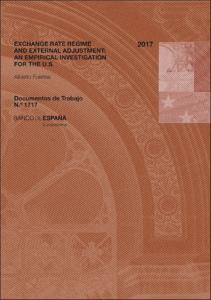Exchange rate regime and external adjustment : an empirical investigation for the U.S
Authors
Issue Date
5-May-2017
Physical description
38 p. : fórmulas, gráficos, tablas
Abstract
Este trabajo analiza la relación entre la posición externa neta de Estados Unidos y el régimen de tipo de cambio. Se detecta una ruptura estructural en la posición externa neta de Estados Unidos al final del sistema de tipo de cambio fijo de Bretton Woods, que modificó tanto la media como la varianza de la serie. En promedio, Estados Unidos pasó de una posición acreedora a una deudora y la varianza de la posición externa aumentó durante el período de tipo de cambio flexible. Este aumento se debe en gran medida al componente de valoración en el ajuste externo, que representa el 54 % de la varianza de la posición externa de Estados Unidos durante el período de tipo de cambio flexible, pero solo el 29 % durante el período con tipo de cambio fijo. También se demuestra que el régimen de tipo de cambio afecta principalmente al componente de valoración en el ajuste de desequilibrios externos. Existe también evidencia de otra ruptura estructural en la posición externa neta de Estados Unidos en el momento de la introducción del euro. Finalmente, hay implicaciones de valoración de activos procedentes de la relación entre el régimen de tipo de cambio y el proceso de ajuste externo, ya que los desequilibrios externos tienen capacidad explicativa sobre la evolución futura del tipo de cambio una vez se tiene en cuenta el régimen cambiario
This paper analyses the relationship between the U.S. net external position and the exchange rate regime. I find a structural break in the U.S. net external position at the end of the Bretton Woods system of fixed exchange rates that changed both the mean and variance of the series. On average, the U.S. changed from a creditor to a debtor position and the variance of the external position increased during the floating period. This increase is to a large extent due to the valuation component of external adjustment, which accounts for 54% of the variance of the U.S. external position during the floating period but only 29% during the fixed exchange rate period. Further analysis shows that the exchange rate regime mainly affects the valuation channel of external adjustment. There is also evidence of another structural break in the U.S. external position around the time of the introduction of the euro. Finally, I document asset pricing implications from the relationship between the exchange rate regime and the external adjustment process, as external imbalances predict future exchange rate developments once the exchange rate regime is taken into account
This paper analyses the relationship between the U.S. net external position and the exchange rate regime. I find a structural break in the U.S. net external position at the end of the Bretton Woods system of fixed exchange rates that changed both the mean and variance of the series. On average, the U.S. changed from a creditor to a debtor position and the variance of the external position increased during the floating period. This increase is to a large extent due to the valuation component of external adjustment, which accounts for 54% of the variance of the U.S. external position during the floating period but only 29% during the fixed exchange rate period. Further analysis shows that the exchange rate regime mainly affects the valuation channel of external adjustment. There is also evidence of another structural break in the U.S. external position around the time of the introduction of the euro. Finally, I document asset pricing implications from the relationship between the exchange rate regime and the external adjustment process, as external imbalances predict future exchange rate developments once the exchange rate regime is taken into account
Publish on
Documentos de Trabajo / Banco de España, 1717
Subjects
Ajuste externo; Régimen de tipo de cambio; Rupturas estructurales; Ajuste por valoración; External adjustment; Exchange rate regime; Structural breaks; Valuation adjustment; Tipos de cambio; Balanza de pagos; Estados Unidos
Appears in Collections:












